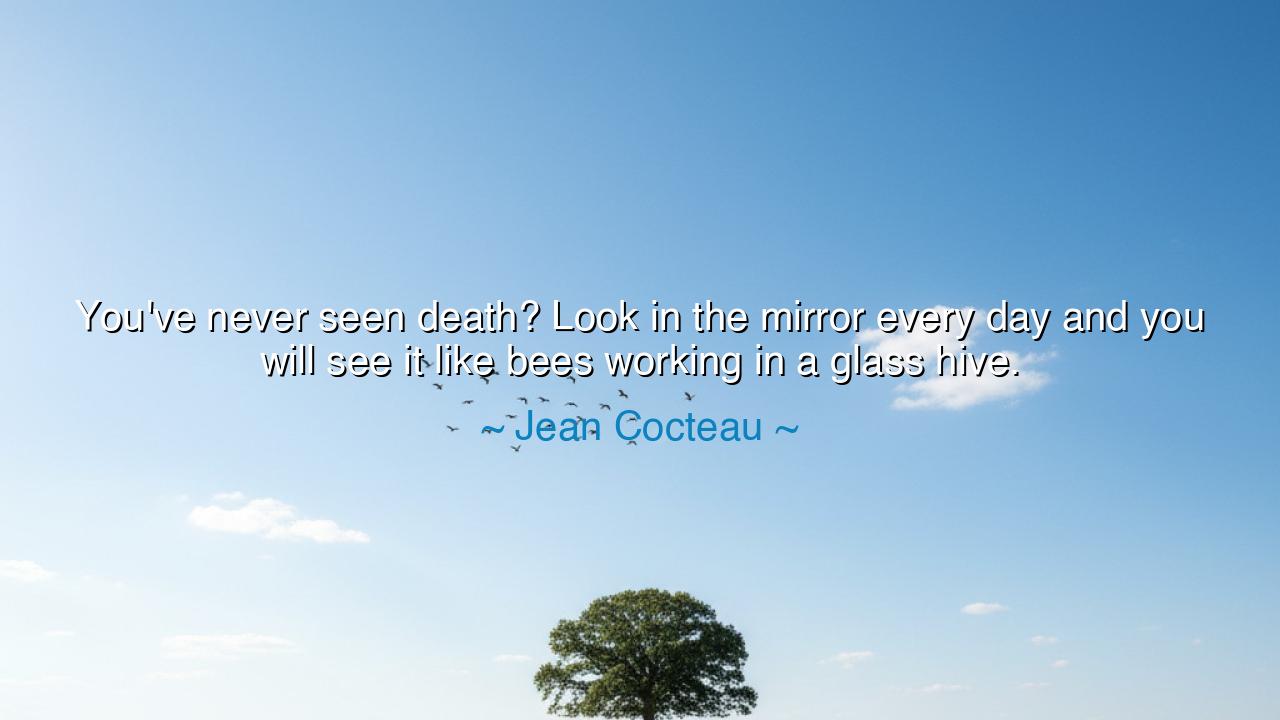
You've never seen death? Look in the mirror every day and you
You've never seen death? Look in the mirror every day and you will see it like bees working in a glass hive.






“You've never seen death? Look in the mirror every day and you will see it like bees working in a glass hive.” Thus wrote Jean Cocteau, the poet of paradox, the dreamer who saw beneath the surface of the visible world. His words shimmer with both beauty and dread, for in them he unveils one of life’s deepest and most unsettling truths: that death is not a distant event, but a constant companion, laboring within us even as we live. Like the silent industry of bees within their hive, unseen yet ceaseless, the forces of decay and transformation work within the human body—turning, changing, preparing the flesh and spirit for their final metamorphosis. Cocteau’s vision is not one of despair, but of revelation; he reminds us that mortality is not our enemy, but the secret architect of our being.
The origin of this quote lies in Cocteau’s lifelong fascination with the boundaries between life and death, art and decay. He was a creator who dwelled among symbols and shadows—an artist who believed that the act of living was itself a kind of slow dying, and that in acknowledging this, one could find freedom. Having lived through the upheavals of two world wars and the loss of many dear friends, Cocteau came to see mortality as the thread that ties together all human experience. When he speaks of seeing death in the mirror, he is not uttering a morbid curse, but offering an awakening: that every wrinkle, every heartbeat, every moment of breath is both the triumph of life and the work of death, entwined like dancers in eternal rhythm.
The image of bees in a glass hive is one of haunting brilliance. The bees, tireless and invisible to the casual eye, represent the inner workings of the body—the cells dividing, the organs laboring, the heart pulsing with life that will one day cease. The glass hive is the mirror, transparent yet reflective, where we see the surface of ourselves but not the deeper movements beneath. Cocteau’s metaphor reminds us that to look upon our own face is to witness a process of transformation that never ends. We are not static beings but living mosaics of creation and dissolution—our skin, our blood, our very atoms constantly dying and being reborn. Death, then, is not a single moment but a lifelong collaboration between the seen and the unseen.
This truth was understood by the ancients, who saw in the cycle of nature a reflection of the human soul. The philosophers of Greece and Rome, from Heraclitus to Marcus Aurelius, taught that all things flow and change, that the same force which gives life also consumes it. The Egyptians, too, revered death as transformation, preparing for it not as an end but as a passage to another form. Cocteau, though writing in a modern age of reason and machinery, returns to this timeless wisdom. He asks us to look not with fear but with wonder at our own mortality—to see it not as decay, but as the sacred movement of life itself, forever building and unbuilding the temple of the body.
There is a story told of the Japanese poet Matsuo Bashō, who, on his deathbed, composed one final haiku:
“Sick on a journey,
my dreams wander the withered fields—
the end of autumn.”
In those few lines, Bashō mirrors Cocteau’s truth. Even in his final weakness, he saw that death was not an interruption of life, but its natural continuation—the season’s inevitable turning. To live is to move toward that winter, and to do so with grace is to make of dying an art. Like the bees that labor toward the making of honey and wax, so too do our bodies and souls labor toward the sweetness of completion. In recognizing the presence of death within us, we learn to live more consciously, to cherish every fragile drop of existence as if it were honey gathered from time itself.
Cocteau’s reflection is, therefore, not a lament but a summons to awareness. When he says, “Look in the mirror,” he urges us to behold the truth without flinching: that beauty fades, that strength wanes, that life itself is fleeting. But rather than despair, we must find liberation in this recognition. For if death is always with us, then each moment becomes infinitely precious. Each breath, each glance, each act of kindness becomes sacred. To see death working within us is to realize that there is no tomorrow guaranteed—and thus we must love fiercely, forgive swiftly, and create boldly, for the hive is always humming, and time is always at work.
So, my friends, let us take from Jean Cocteau’s wisdom the courage to look upon our reflection not with vanity, but with reverence. See in your face the story of the cosmos—the atoms born from dying stars, the pulse inherited from generations before you, the slow and beautiful labor of life and death interwoven. You are the hive, and within you hums the great work of the universe. Do not fear the bees; they are not your destroyers, but your sculptors.
Live, therefore, not as one who denies death, but as one who walks hand in hand with it—knowing that to die a little each day is to truly live. For in that quiet, shimmering mirror, where life and death work together, you will see not decay, but creation eternal—the ceaseless artistry of existence itself.






AAdministratorAdministrator
Welcome, honored guests. Please leave a comment, we will respond soon